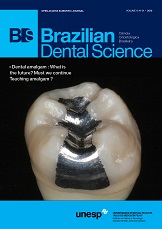Color stability of artificial teeth after exposure to acid and staining agents
DOI:
https://doi.org/10.14295/bds.2015.v18i1.1068Abstract
Objective: Changes in color of artificial teeth mainly occur due to ingestion of beverages and use of products for cleaning and disinfection. The more aggressive solutions must be identified and the patient provided with explanations in order to avoid or reduce the frequency of their use, to a higher longevity of the denture. The purpose of this study was to evaluate the changes in color of artificial teeth before and after immersion in beverages and disinfectants. Material and Methods: 96 artificial resin teeth were randomly divided into 8 groups. Each group was immersed for 10 min into a test solution (coffee, lemon juice, chlorhexidine gluconate, red wine, cola-based soft drink, vinegar or antiseptic with and without alcohol) and then the specimens were stored in artificial saliva for 23 h and 50 min, completing a period of 24 h. This procedure was performed for 14 consecutive days and after this period the second color measurement was made.The data obtained with the spectrophotometer using the CIEL*a*b* system were statistically analyzed using ANOVA non parametric, Kruskal-Walis and the Dunn test. Results: There were found differences in color variation for each experimental group after the challenge. statistically significant differences were found between the coffee, red wine and lemon juice groups. Conclusion: All the substances changed the color of artificial teeth; coffee was the substance that caused most staining of artificial teeth, altering color and luminosity; the oral antiseptics with and without alcohol promoted whitening of the artificial teeth.
Keywords: Artificial tooth; Denture; Oral rehabilitation; Staining.
Downloads
Downloads
Published
How to Cite
Issue
Section
License
Brazilian Dental Science uses the Creative Commons (CC-BY 4.0) license, thus preserving the integrity of articles in an open access environment. The journal allows the author to retain publishing rights without restrictions.
=================




























